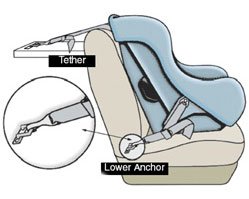
LATCH stands for Lower Anchors and Tethers for CHildren.
LATCH is a way to secure a car seat to a vehicle using straps or connectors on the car seat that connect to dedicated metal anchors in the vehicle.
LATCH is known as ISOFIX in Europe and LUAS (Lower Universal Anchorage System) in Canada.

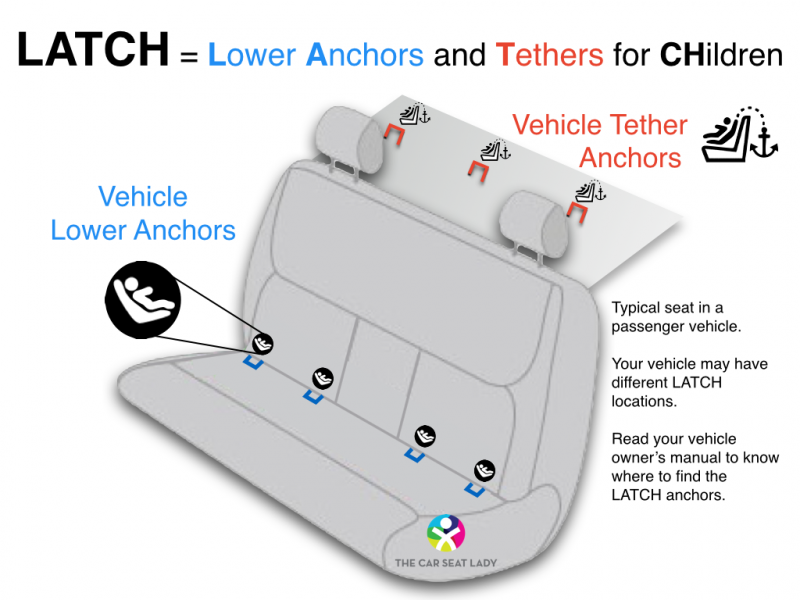
LATCH is a way to secure a car seat to a vehicle using straps or connectors on the car seat that connect to dedicated metal anchors in the vehicle.
LATCH is known as ISOFIX in Europe and LUAS (Lower Universal Anchorage System) in Canada.
In the vehicle: Lower anchors and tether anchors are built-in to the vehicle.
On the car seat: Connecting straps and hooks are built-in to the child’s car seat.
Lower Anchors: These are a pair of metal “u-shaped” bars hidden in the vehicle’s seat crack. Learn how to identify them here.
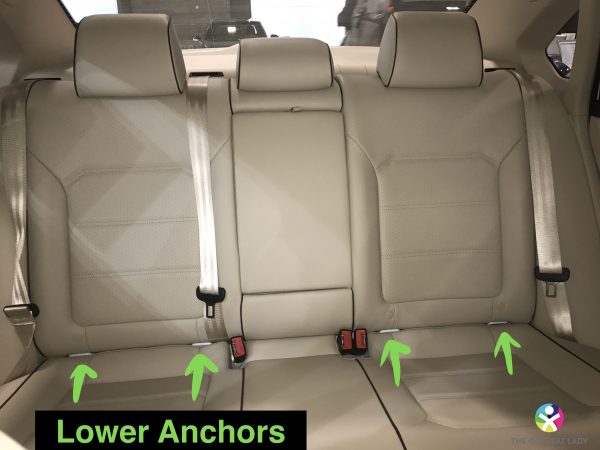
Tether Anchors: These are metal rings or bars found behind the vehicle seat. In sedans, the tether anchors are always on the shelf under the rear windshield. In SUVs, wagons, and minivans the location can vary tremendously.
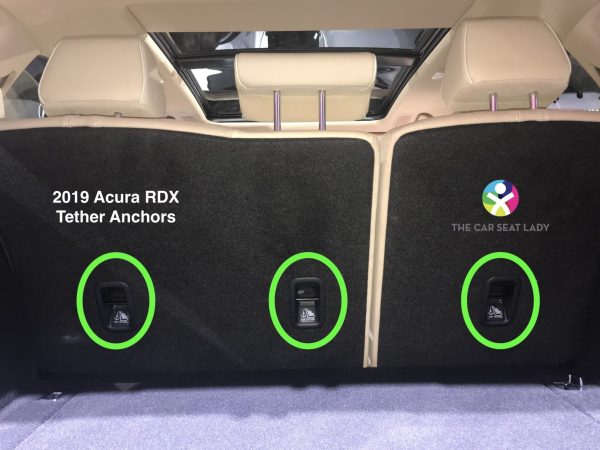
Does your vehicle have both? If you live in the US, your vehicle probably has both lower anchors and tether anchors.
In the U.S., federal regulation mandates that vehicles model year 2003 and newer must have lower anchors in at least TWO positions and tether anchors in at least THREE positions. This means that in most vehicles, the side seats have lower anchors AND tether anchors, while the center seat has a tether anchor but NO lower anchors. See here for which vehicles have lower anchors for the center seat.
Vehicles with a third row may or may not have lower anchors or tether anchors for those seats.

Lower anchor connectors: ALL 5-point harness car seats (including rear-facing only infant seats, convertible car seats, “harnessed boosters” and “all in one” car seats) and some belt positioning boosters come with built-in lower anchor connectors.
Tether strap and hook: All forward-facing 5-point harness car seats (including convertible car seats, “harnessed boosters” and “all in one” car seats) come with a built-in tether strap and hook. The tether is the MOST IMPORTANT PART of every forward-facing car seat.

All car seats with a 5-point harness have a way to connect to the lower anchors in the vehicle. Most car seats use a lower anchor strap with a hook on each end that hooks onto the vehicle’s lower anchors. Some car seats have two separate lower anchor straps, each with a hook on one end.
Lower anchors and connectors are used INSTEAD of the vehicle’s seat belt to secure the child seat to the vehicle. Lower anchor connectors are found on both rear-facing and forward-facing car seats, as well as on some boosters.
In the US, there are a few child safety seats that have rigid or semi rigid LATCH – where the lower anchor connectors are not on a strap, but rather rigidly attached to the steel frame of the child’s car seat. Currently, the Nuna Pipa and Clek Liing are the only 2 rear-facing-only seats with rigid LATCH, and the Clek Foonf is the only seat to offer rigid LATCH for forward-facing.
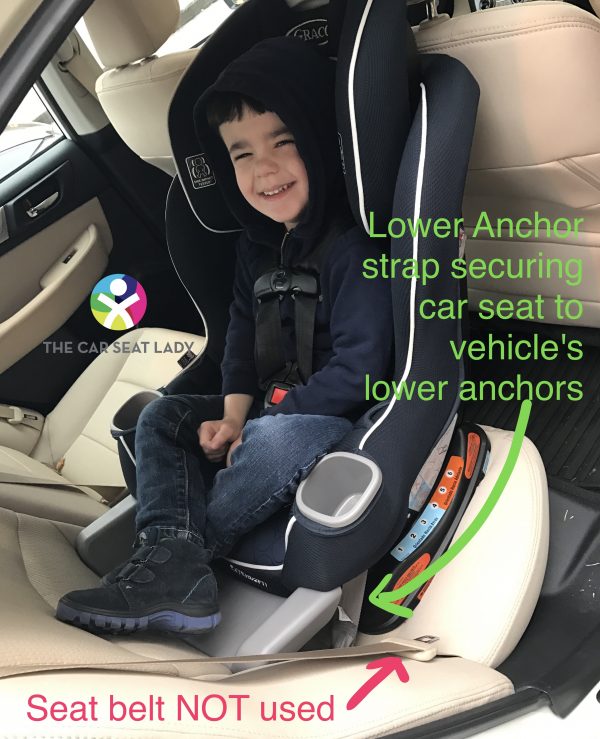
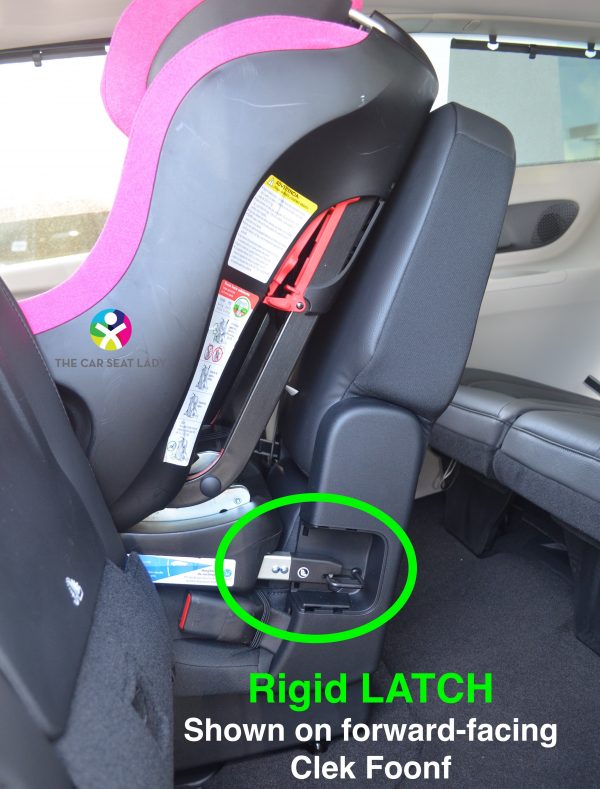
Where are they on the car seat?
Lower anchor connectors can be hard to find on the car seat! On an infant seat they may be hooked onto the side of the base, or snapped into storage slots, or folded up in a panel on the base. On a convertible car seat or a forward-facing car seat, they may be clipped to storage bars on the side of the seat, stored in a compartment under the cover or on the back of the car seat’s base, or clipped onto the back of the car seat. In all cases, use the car seat’s instruction manual to help you locate the connectors. If you choose to install your car seat using LATCH, read the instructions in your car seat’s instruction manual and in your vehicle owner’s manual (yes, look at both manuals!!).
Which one should I use? Lower anchors or the seat belt?
It depends!
Some car seats are optimized for a seat belt installation while others are optimized for lower anchors. Some manufacturers have specified which method they recommend using, but most leave it to parents to choose.
Some car seats require the use of one system or the other depending on the child’s weight, vehicle features such as where the lower anchors are placed, inflatable seat belts or 3rd row access, or something else.
If you want to place the car seat in the center of your vehicle, you almost always CANNOT use lower anchors, since most vehicles do not provide lower anchors for that seating position. Your vehicle owner’s manual will indicate which seating positions have dedicated lower anchors.
ALWAYS read your car seat’s instruction manual to find out how to install it, and call the car seat manufacturer if you have any questions regarding installation.
Our answer: Sometimes.
Seat belts have always been a very safe and effective way to secure a car seat… the problem is that getting a secure installation with a seat belt is often confusing and challenging. LATCH was invented in an attempt to decrease the misuse rate for car seats by giving parents an easier way to secure the child’s car seat to the vehicle. Unfortunately, LATCH did not reduce the misuse rate for car seats; the misuse rate continues to be approximately 90%. Lower anchors also now have maximum child weight limits above which you cannot use them and must use the seat belt for installation.
One type of lower anchor connector may be safer — rigid LATCH. By directly securing the steel frame of the child’s car seat to the steel frame of the car, rigid LATCH virtually eliminates the side-to-side motion of the car seat in a side-impact and the front-to-back motion of the car seat in a frontal crash. As such, rigid LATCH can better contain the child’s body within the shell of the seat and decreases the chance of the child’s body hitting a hard structure in the vehicle, since the child’s seat can not move as much laterally or front-to-back as it can with seats that use a lower anchor strap or a seat belt. Rigid LATCH also has a much lower potential for mistakes to be made in installing the seat compared to when you need to tighten a lower anchor strap or seat belt.
NO (usually). The lower anchors are typically used INSTEAD OF the vehicle’s seat belt.
But……there are a few exceptions. The most common exception is with booster seats that offer LATCH, where the lower anchors will secure the booster to the vehicle, and then the vehicle’s seat belt goes across the child’s body to secure the child.
For 5-point harness car seats, there are only 2 seats that currently allow you to use the lower anchors AND seat belt. 1. The Clek Foonf (a convertible seat) when used FORWARD-facing uses the rigid lower anchor connectors AND the vehicle’s seat belt (and the tether too) – which effectively negates the entire issue discussed below of the lower anchors having weight limits. 2. The Nuna Pipa infant seat also allows the use of the rigid lower anchor connectors AND the vehicle’s seat belt.
Unless you have a Nuna Pipa base or a forward-facing Clek Foonf, NO you cannot use both. Trust that the car seat manufacturer knows their seat best. Unless they tell you to use both, they don’t want you to use both.
The tether is the most important part of EVERY forward facing car seat. Every single forward-facing car seat in the US has a tether strap. The tether strap comes from the top of the car seat and has a hook on the end that will connect to the tether anchor in the vehicle. EVERY forward-facing car seat is safer when used with the tether.
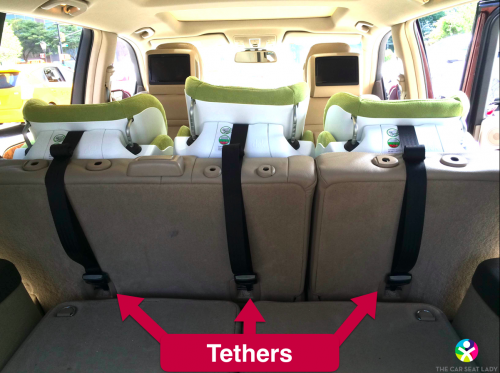
Why is it safer to use the tether?
Using the tether will decrease how far the child’s head will move in a crash by at least 4-6 inches typically. The less the head moves forward, the less likely it is to hit hard parts in your vehicle–like the door frame, the window, the back of the front seat, or even other passengers. The tether also reduces the amount of acceleration and how much force is applied to the neck during a crash.
In action: This video shows the same car seat with the same dummy in the same crash test… the only difference is that the seat in the foreground is using the tether strap, while the seat in the background is not. In a real car with a vehicle seat in front of you, you can easily imagine that the dummy in the background could hit his head on the back of the front seat or other hard structures because his head moves so much farther forward.
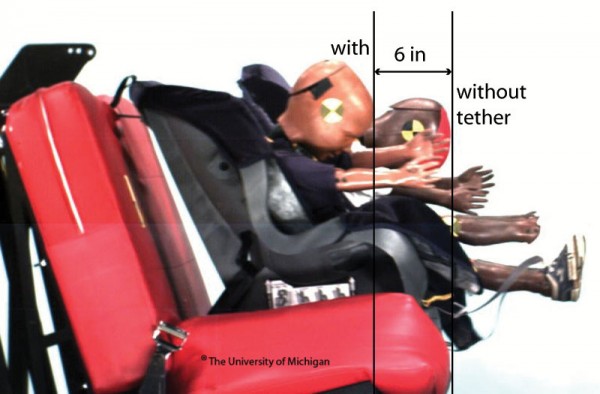
Tethers are never used by themselves; they are always used in addition to the lower anchors or the vehicle’s seat belt.
If you have a forward-facing car seat and installed it with the vehicle’s seat belt, you should also use the tether strap.
If you have a forward-facing car seat and installed it with the lower anchor strap/rigid LATCH, you should also use the tether strap.
Note: Tethers are for forward-facing car seats – where the child uses a 5 point harness as their restraint. Tethers aren’t required (or often found) on boosters – where the child uses the vehicle’s seat belt across them as their restraint.
| CAR SEAT TYPE | LOWER ANCHORS? | TOP TETHER? |
| REAR-facing-only CARRIER | NO (exception: when carrier is sold withOUT base) | NO |
| REAR-facing-only BASE | YES | NO |
| REAR-facing CONVERTIBLE | YES | YES (a few allow the use of the tether when seat is rear-facing) |
| FORWARD-facing with 5-Point Harness | YES | YES |
| BOOSTER with a HIGH back | MAYBE(some allow use of lower anchors in booster mode) | MAYBE (some allow use of tether in booster mode) |
| BOOSTER with NO back | MAYBE(some allow use of lower anchors in booster mode) | NO |
